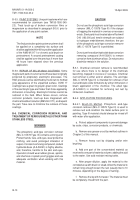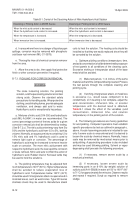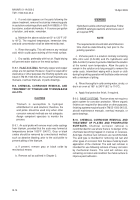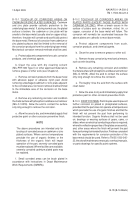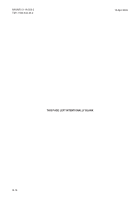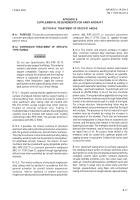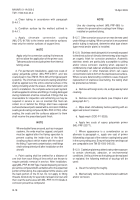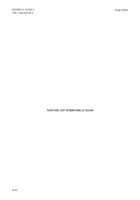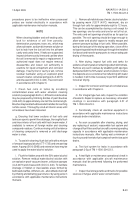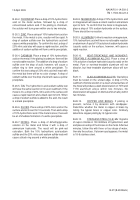TM-1-1500-344-23-2 - Page 220 of 240
B-18
NAVAIR 01-1A-509-2
TM 1-1500-344-23-2
15 April 2009
a. Clean tubing in accordance with paragraph
B-4.4.1.
b. Condition surface by the method outlined in
B-4.4.1.
c. Apply
chromate
conversion
coating
(MIL-DTL-81706) to the interior and exterior surfaces;
treat only the exterior surfaces of oxygen lines.
NOTE
Apply only the conversion coating if tolerances
will not allow the application of the primer coat.
Take precautions to exclude primer from internal
tubing areas.
d. For permanent installations, apply two coats of
epoxy polyamide primer (MIL-PRF-23377) and two
coats of paint. (See TM 55-1500-345-23 for typical paint
systems). The chromate conversion coating and primer
shall be applied over the entire external surface of the
tubing including under the sleeve. After fabrication and
prior to installation, the complete exterior paint system
shall be applied to all lines and fittings. Coating damaged
during installation shall be retouched. Fittings that are
inaccessible for inspection and refinishing as may be
required in service or are so oriented that fluid can
collect on or behind the fittings shall have exposed
surfaces between parts sealed with a corrosion inhibitive
sealing and coating compound (MIL-PRF-81733). After
sealing, the seals and the surfaces adjacent to them
shall receive the prescribed paint finish.
NOTE
Where double flares are used, such as in oxygen
systems, the ends must be capped, and paint
must be applied after the flaring operation to
prevent coating the inside face of the flare
(sealing surface) which mates with the seat of
the fitting. To prevent contamination, end fittings
shall not be painted until after installation on the
aircraft.
e. Paint coating shall be omitted for a distance of
one inch from each fitting of lines which are known to
require periodic removal in service. After installation,
apply MIL-PRF-81309 Type II water displacing corrosion
preventive compound with a small brush to the unpainted
portion of the tubing, the exposed part of the sleeve, and
the back portion of the B nut. Do not apply to fitting
threads. Allow to dry for a period of at least one hour and
then coat the same area with MIL-PRF-16173 Grade 4
corrosion preventive compound.
NOTE
Use dry cleaning solvent (MIL-PRF-680) to
remove the preservative coatings from fittings
installed on painted tubing.
B-12.7. Often corrosion occurs on or near sleeves used
under fittings on tubing. When corrosion is encountered
and/or tubing is replaced, determine what type sleeve
(type metal and/or plate) is installed.
B-12.8. Stainless steel tubing which is normally exposed
to the direct action of climatic elements may also require
an organic finish for corrosion protection. Austenitic
stainless steels are particularly susceptible to pitting
and/or stress corrosion cracking when exposed to
combinations of salt-laden air and dust particles (metallic
or nonmetallic) or other materials which can cause
concentration cells to form on the stainless steel surface,
Where severe deteriorating conditions cause frequent
replacement of stainless steel tubing, the tubing shall
be protected as follows:
a. Remove all foreign soils, oils, and grease by hand
cleaning.
b. Remove corrosion products (see Chapter 4 and
paragraph B-7.).
c. Wipe down immediately before painting with an
approved solvent cleaner.
d. Apply wash (DOD-P-15328).
e. Apply two coats of epoxy polyamide primer
(MIL-PRF-23377).
f. Where appearance is a consideration as an
alternate to paragraph e., apply one coat of primer
followed by a topcoat of the exterior coating being used
in the surrounding area. Ensure that primer and topcoat
are compatible (see TM 55-1500-345-23).
B-12.9. Cadmium plate may deteriorate under exposure
to certain chemicals, abrasion, or environmental
conditions. Until such time as the tubing can be replaced
or replated, the following method of touchup will be
used:
a. Clean the tubing thoroughly.
b. Mechanically remove the deteriorated cadmium
and/or corrosion.
Back to Top



